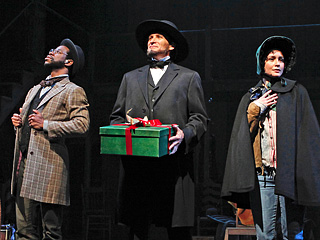Some people, like my sister Joanne, revel in the holiday
season and in all the holiday-themed shows that come with it. Other people,
like me, bah humbug our way through both.
Which is why I always invite Joanne to go with me to any show that has
Christmas in its title or parts that call for cast members to dress like elves.
It’s also why this post may reflect more of my sister’s
sentiments than mine about A Christmas Story The Musical, currently playing at
the Lunt-Fontanne Theatre, and A Civil War Christmas, which just opened down at New
York Theatre Workshop.
Despite my chronic Grinchitis, I had been looking forward to
both shows. A Christmas Story marks the Broadway debut of the up-and-coming musical
team of Benj Pasek and Justin Paul, whose show Dogfight impressed me when it
played at Second Stage Theatre last summer (click here to read my review). Meanwhile, A Civil War Christmas is written by Paula
Vogel, whose Pulitzer Prize-winning How I Learned to Drive I’ve already
nominated for the Mount Rushmore of great American plays (click here to read my review of the recent revival of that).
The good news is that both are smartly produced, nicely performed and entertaining in a one-size-fits-all kind of way that makes them
perfect fare for the entire family, even those out-of-town Cousin Rogers whom
you hardly know anymore but who always seem to show up for the holidays.
The bah humbug news is that, as Christmas shows usually do, A Christmas Story and A Civil War Christmas wear the morals of their tales conspicuously on their lapels.
Both plots
are thin, unspooling in only loosely connected scenes. And there’s not much subtlety in either show.
Their goal is to provoke a smile or to tug at the heartstrings.
But none of that mattered to my sister who
thoroughly enjoyed both. And here's why:
A Christmas Story is based on the memoirist Jean Shepherd’s tale
about a Midwestern kid in the 1940s who desperately wants a BB gun for
Christmas. Shepherd’s story was made into a now-classic holiday movie, which,
it will come as no surprise, I’ve never seen.
But Joanne has and she says the musical (Joseph Robinette did the book)
is faithful to the movie—only better.
If that’s so, the credit has to be spread around. Pasek and Paul get points for putting together a sprightly
score that is faithful to the traditional Broadway sound and chocked full of
Christmas anthems (click here to read a piece about them). But the spot at the top of the list should go to director John
Rando and choreographer Warren Carlyle who have filled the show with one
terrific production number after another.
And the cast is equally deserving of praise. Two kids share the lead role of Ralphie, the boy who wants the BB gun. Joanne and I
saw Johnny Rabe, whose unaffected stage presence belies his young years. He didn't miss a beat when the chaps he wears in one fantasy sequence suffered a wardrobe malfunction that caused them to fall during our performance.
But all
the kids are great, particularly Jeremy Shinder, who plays Ralphie’s roly-poly
best friend, and Luke Spring, a little scene-stealer who does the best tap
number I’ve seen since the last time Savion Glover was onstage.
The adults
are fine too, especially John Bolton, who brings a loose-limbed goofiness to
Ralphie’s eccentric dad (click here to read a Q&A with him).
A Civil War Christmas is, as you might expect, a quieter
show. But it’s filled with music
too. Nearly half of its two and a half
hours is given over to the singing of Civil War ballads and Christmas carols.
Vogel says she wrote the play to honor her dying
brother's wish that the children in their family be taught more about American history.
She was further inspired by the horrors of Hurricane Katrina to write a play
that deals head-on with race. She spent two years researching this piece. (Click here to read an interview with her.)
The result is a series of scenes on Christmas Eve 1864 that makes
stops at the frontlines of battle where soldiers on both sides yearn to be with
loved ones, the homes of free blacks in the Georgetown section of Washington cautiously
hopeful about the approaching full end of slavery, the boarding house where John Wilkes
Booth is plotting to kill the president, a hospital where Walt Whitman is
tending patients and the White House, where the First Lady is eager to install
one of the newly-fashionable Christmas trees.
Tina Landau has directed this historical pageant in story theater fashion.
The actors narrate the story and take on multiple roles without paying
attention to age, gender, race or, in one case, the species of the character
they’re assuming.
Alas, the talent on display is also something of a mixed bag.
Among the goodies is little Sumaya Bouhbal, who seems to have recently lost her front baby teeth but more
than holds her own with the adults in the cast.
It was also hard to look away from Bob Stillman who might give Daniel
Day-Lewis a run for his money in an Abe Lincoln-look-alike contest. And Alice
Ripley brings the manic intensity she honed in her Tony-winning performance as
the bipolar mother in Next to Normal to the character of the similarly troubled
Mary Lincoln.
I found it all to be a bit sketchy but Joanne was enchanted
by A Civil War Christmas. She was further delighted to discover that Vogel was sitting just a few seats away from us. You might not get that big a treat if you go but seeing either of these shows will probably fill you with the holiday spirit, even if you're not big on that kind of thing.



No comments:
Post a Comment